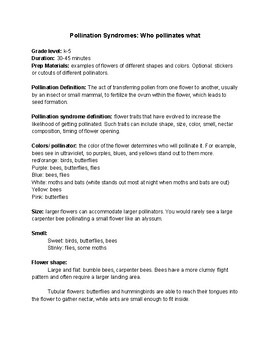Pollination Syndromes Lesson and Activities: Who pollinates what
adrienne wallace
1 Follower
Grade Levels
PreK - 5th
Subjects
Resource Type
Standards
NGSS1-LS1-1
NGSS4-LS1-1
NGSSK-ESS3-1
NGSS2-LS4-1
NGSS4-LS1-2
Formats Included
- PDF
adrienne wallace
1 Follower
Description
This lesson details which animals pollinate different kinds of flowers based on shape, color, size, and smell
Total Pages
Answer Key
N/A
Teaching Duration
N/A
Report this resource to TPT
Reported resources will be reviewed by our team. Report this resource to let us know if this resource violates TPT’s content guidelines.
Standards
to see state-specific standards (only available in the US).
NGSS1-LS1-1
Use materials to design a solution to a human problem by mimicking how plants and/or animals use their external parts to help them survive, grow, and meet their needs. Examples of human problems that can be solved by mimicking plant or animal solutions could include designing clothing or equipment to protect bicyclists by mimicking turtle shells, acorn shells, and animal scales; stabilizing structures by mimicking animal tails and roots on plants; keeping out intruders by mimicking thorns on branches and animal quills; and, detecting intruders by mimicking eyes and ears.
NGSS4-LS1-1
Construct an argument that plants and animals have internal and external structures that function to support survival, growth, behavior, and reproduction. Examples of structures could include thorns, stems, roots, colored petals, heart, stomach, lung, brain, and skin. Assessment is limited to macroscopic structures within plant and animal systems.
NGSSK-ESS3-1
Use a model to represent the relationship between the needs of different plants or animals (including humans) and the places they live. Examples of relationships could include that deer eat buds and leaves, therefore, they usually live in forested areas; and, grasses need sunlight so they often grow in meadows. Plants, animals, and their surroundings make up a system.
NGSS2-LS4-1
Make observations of plants and animals to compare the diversity of life in different habitats. Emphasis is on the diversity of living things in each of a variety of different habitats. Assessment does not include specific animal and plant names in specific habitats.
NGSS4-LS1-2
Use a model to describe that animals receive different types of information through their senses, process the information in their brain, and respond to the information in different ways. Emphasis is on systems of information transfer. Assessment does not include the mechanisms by which the brain stores and recalls information or the mechanisms of how sensory receptors function.



